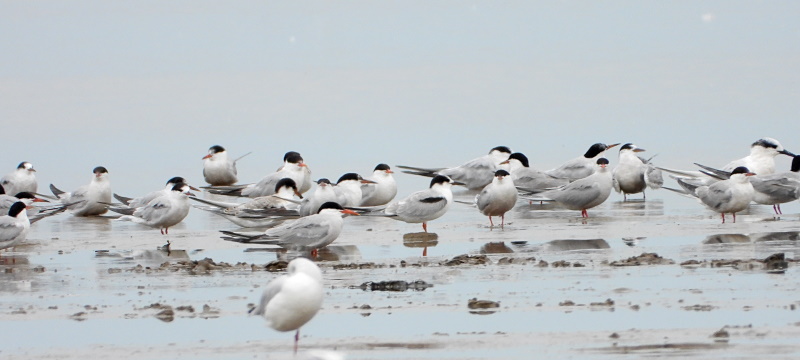Dee Estuary Birding
Monthly Newsletter...
August 2024
Newsletter
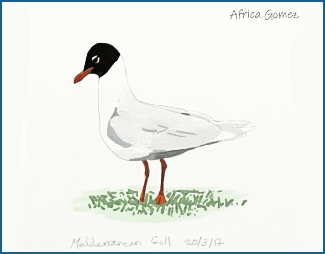
Wetland Bird Survey Annual Report
2022/23
Summary and Highlights

Both the Dee Estuary and National Wetland
Bird Survey Reports for 2022/23 have recently been published and here
I've written my normal summary and highlights.
The
National Report consists of a written report with a lots of interesting
articles, plus there is a large amount of data which can be
accessed on-line - not just for 2022/23 but going all the way back to
the days of
the beginning of the Birds of Estuaries Enquiry (BoEE) in the 1960s.
Most of the data consists of the high tide counts carried out monthly
but there are also Low tide counts, Non-Estuarine shorebird counts and
various analysis of trends. All this, the report and the data, can be
accessed from the WeBS page
on the BTO website -
https://www.bto.org/our-science/projects/wetland-bird-survey/publications/webs-annual-report
'Waterbirds in the UK 2022/23 The
annual report of the Wetland Bird Survey and the Goose & Swan
Monitoring Programme' - to give it's full title, includes an
article 'Travellers from the north and north-east' all about the birds
which migrate here from Svalbard, Scandinavia, the countries around the
Baltic Sea and Russia. As you will no doubt know Liverpool Bay is an
important wintering site for Red-throated Divers and I was amazed to
learn, via the detailed map showing both ringing and tracking data,
that these birds travel as far as Greenland in the west to the Taimyr
Peninsula in the east. There are similar maps for another five species
including Bar-tailed Godwit and there is also a 'Focus
on... Bar-tailed Godwit' article - particulary pertinent at the moment
with the large numbers of this species over-summering at Burton Mere
Wetlands.
2022/23 marked the 30th anniversary of the start of
the Low Tide WeBS counts, and the estuaries surveyed included the Alt,
just across the Mersey channel from North Wirral. The area covered
goes from Formby Point in the north to Seaforth NR in the south which
is a large area with much interchange of birds between there and North
Wirral and
the Dee Estuary. The article in the report - 'Alt Estuary at low tide'
is a fascinating read.
Dee Estuary and North Wirral Foreshore WeBS Annual Report 2022/23
I've selected five species from this report giving a summary of their current status on the Dee Estuary and in the national context.
Little Egret
When I first started this website in 1998 Little
Egrets were still very scarce and total counts for the whole estuary
were in single figures. I remember well driving to Parkgate trying to
find one or two to report on my latest sightings page. At that time all
the big numbers were on the south coast, never did we think that the
Dee Estuary would become the second most important site in the country
for them. 476 (a record high number for WeBS) were counted in September
2022, only the Thames Estuary, with 540, had a higher number. 91 nests
were counted at Marsh Covert (Burton Mere Wetlands) in 2023 and
several more nested at other sites around the estuary. Additionally, we
know from colour ringing that young birds fly to the Dee after being
hatched at other colonies such as at Hale Duck Decoy and Penryn Castle.
Wigeon

In November 2022 the number of Wigeon counted on the Dee Estuary was
8,497, the second highest ever count here. This marked a remarkable
turnaround since 2012 when the count was only 1,177.
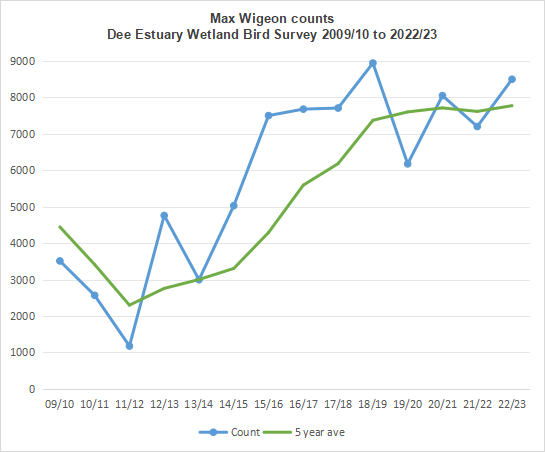
From the low point during the winter of
2011/12 there has been a steep increase and since 2015/16 the
average has been around 7,700. This is well above the National
Important number of 4,500 although still well below the International
Important threshold of 14,000. The most important site in the country
for Wigeon is the nearby Ribble Estuary where the current five year
average is a whopping 51,175.
Shoveler
In 2022/23 there were high counts from September to
January with a record high in October of 334, which was a big increase
from the previous winter's peak of 202. On a non-WeBS day 186 were
counted on Boathouse Flash at Parkgate. Both the national and local
trends show a steady rise in numbers over the past forty years or so
with only a series of relatively cold winters between 2009 and 2013 to
slow the increase.
Good numbers breed around the Dee Estuary with 23
confirmed breeding pairs at Burton Mere Wetlands in 2022 and 39 in 2023
- with more pairs elsewhere.
Curlew
Sandpiper
Being a scarce migrant which we only normally record
for just a few weeks in autumn, Curlew Sandpiper isn't a species which
usually features in the WeBS report. But September 2022 saw a
particularly strong passage and, as it happens, the peak coincided with
the WeBS counting day on the 11th. On the Dee Estuary the WeBS count
was 48 including 39 at Burton Mere Wetlands, a record high for that
site. This was the second highest count in the country that day, with
63, on the Wash, being the highest. Nationally, the total came to 278
which was the largest count this century.
Dunlin

As part of the team monitoring Liverpool Bay Knots, doing counts and
reading colour rings, I spend a lot of time out in the estuary and I
couldn't but help notice, during the winter of 2022/23, that Dunlins
were everywhere! WeBS counts were over 18,000 in November and December,
and over 25,000 from January to March with a peak count of 26,652 in
Jan - the highest for 20 years. I was seeing feeding flocks out on the
mud flats but the high tide roosts were particularly spectacular, as
you can see from the photo above.
Our next door estuary, the Mersey, is the most
important site in the country for Dunlin and they had their second ever
highest count there in the winter of 2022/23 with 66,284. WeBS counts
always take place on the same date each month right across the country,
and it's interesting that the max WeBS counts for 2022/23 on the Dee,
Mersey, Ribble and Morecambe Bay were all on January 22nd making for a
massive total of 145,132 Dunlin in north-west England.

Sources of Information
1. Woodward, I.D., Calbrade, N.A., Birtles, G.A.,
Peck, K., Wotton, S.R., Shaw, J.M., Balmer, D.E. and Frost, T.M.
2024.
Waterbirds in the UK 2022/23: The Wetland Bird Survey and Goose &
Swan Monitoring Programme. BTO/RSPB/JNCC/NatureScot. Thetford.
2. Neil Friswell and Colin Wells, Dee Estuary and North Wirral Foreshore WeBS Annual Report, 2022/2023.
Note: This
article contains Wetland Bird Survey (WeBS) data from Waterbirds in the
UK 2022/23 © copyright and database right 2024. WeBS is a partnership
jointly funded by the BTO, RSPB and JNCC, with fieldwork conducted by
volunteers and previous support from WWT.
Richard Smith
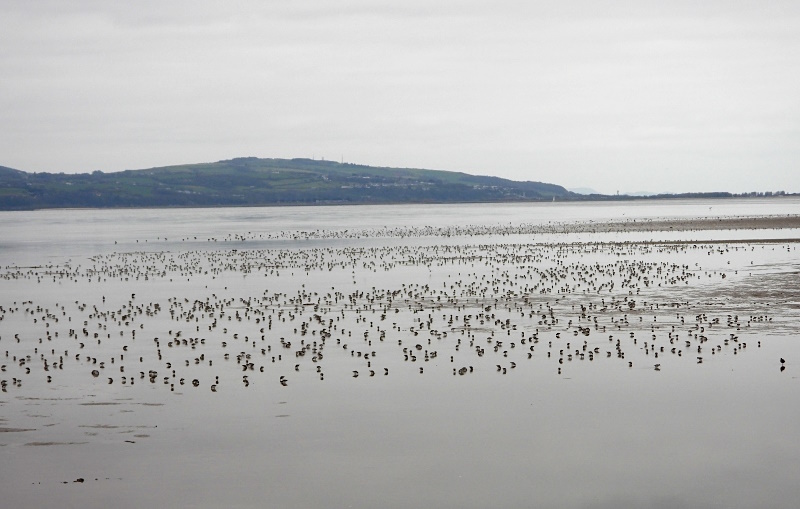
Colour Ring Report
July was a very busy month for Colour rings, especially on Knots!
Below is a brief summary of some of the highlights.
Black-tailed Godwits
Fascinating birds, Black-tailed Godwits. They have
been colour-ringing them for something like 30 years, so they are well
studied. Here, on the Dee Estuary, we've been recording them for around
22 years and in July this year we saw our 306th colour ringed blackwit.
We have found that that each bird has its favourite sites for their
summer moult, their favourite wintering area and their favourite spring
moult site before they fly to Iceland to breed. For some these
favourite spots can be in one relatively small area (perhaps the Dee
and Mersey estuaries), for others they can range through the whole of
western Europe - such as L5YLBR below.
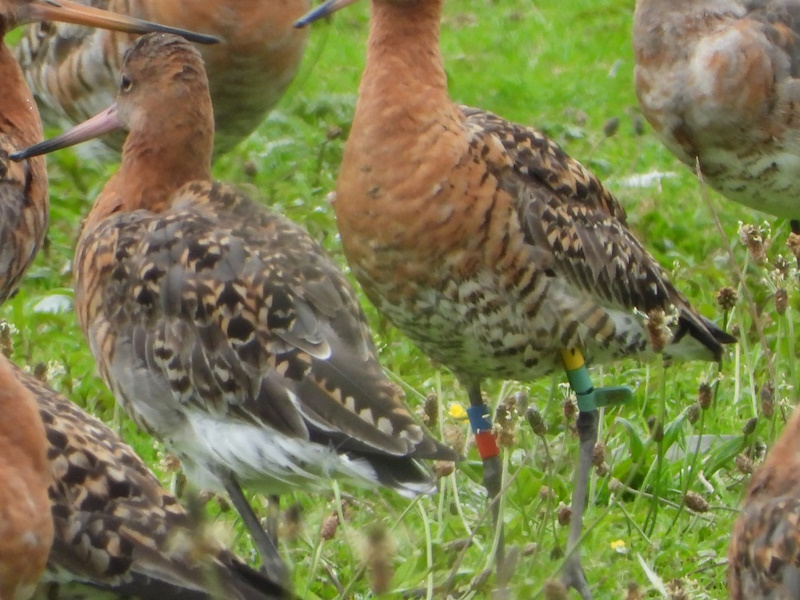
L5YLBR
Ringed in Friesland, Netherlands, in March 2021.
The map shows some interesting movements. It spends late summer in the
Dee Estuary area before moving south for the winter. There is a gap of
several months between it leaving here and arriving at the Tagus
Estuary in the second half of the winter, perhaps it spends this time
on the Atlantic coast of France or northern Spain. Most records in
Portugal are when it is feeding in the rice fields where large flocks
are present. In late winter/spring it flies north-east to the
Netherlands (via northern Spain) before heading north-west to Iceland
to breed. This north-east movement is seen a lot with birds that winter
in Spain and Portugal, we think they probably fly with the continental
race of Black-tailed Godwits (Limosa
limosa) which are returning to the Netherlands to breed after
spending the winter in Africa.
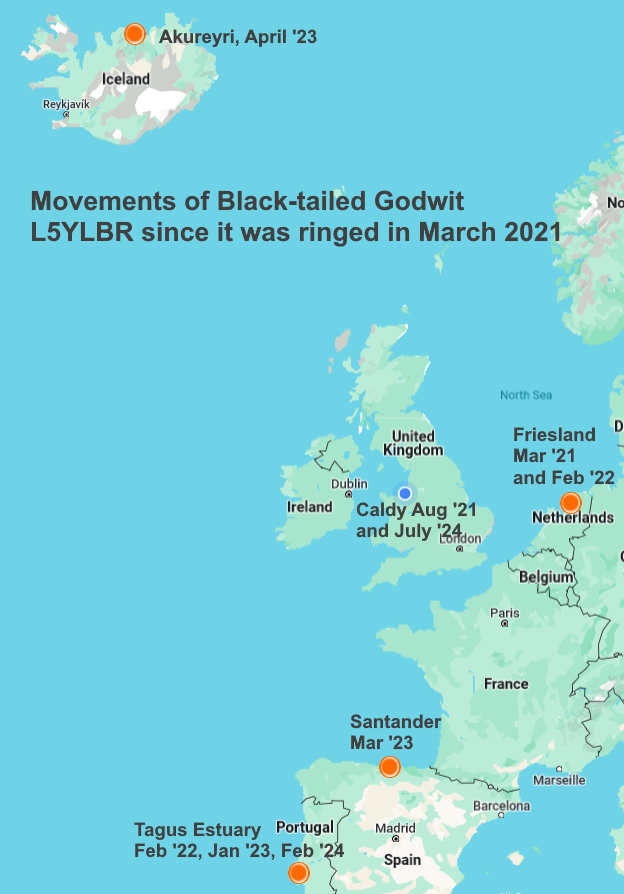

Y - RO//W
This bird is a good age having been ringed as an adult at Holbeach, the
Wash, in August 2010.
When not in Iceland it spends all it's time in the United Kingdom but
moves around a lot! It spends most of it's time on the east coast
ranging from the Humber Estuary in the north to the Stour Estuary,
Essex, in the south. But it has also been recorded at Burton Mere
Wetlands, Carr Lane Pools (Mersey Estuary), Frodsham Marsh, Marshside
(Ribble Estuary) and Belfast Lough.
Avocet
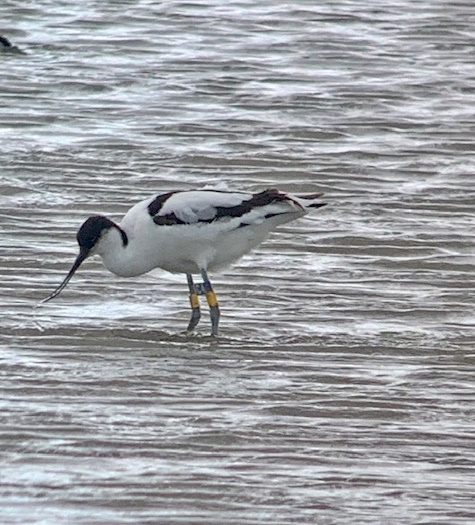
Blue flag (C4)
Ringed at Conder Green on the River Lune Estuary (Lancs) in July 2023,
as a chick.
It was recorded several times at Conder Green up to the first week in
August that year.
The next record was at Pilning Wetlands on the Severn Estuary in March
2024 before it returned to Conder Green in April.
It was next seen at Burton Mere Wetlands in June 2024.
Black-headed Gull
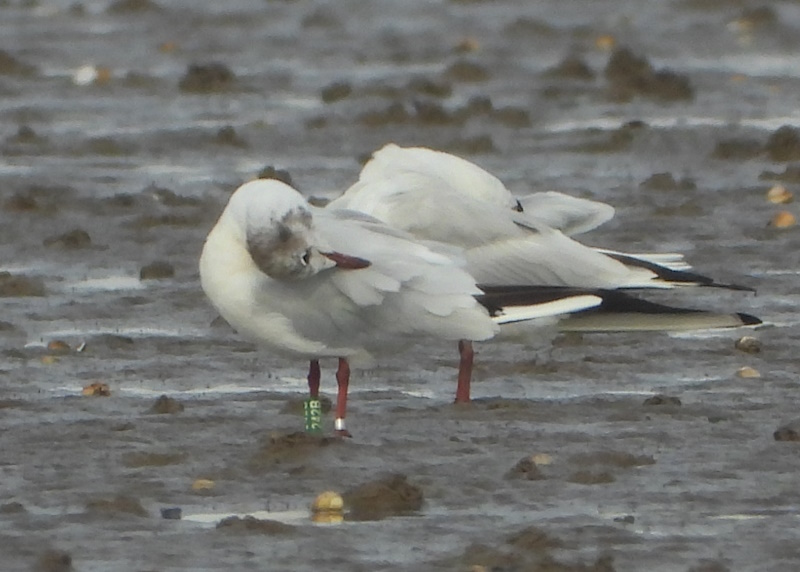
G -242B
Ringed at Center Parcs, Sherwood Forest, in October 2022.
It was recorded there several more times, the last being in January
2024.
Recorded on West Kirby Shore on 9/07/2024.
Our first record of a bird ringed at a Center Parcs,
and first record of one ringed in a famoud ancient forest!
Mediterranean Gull
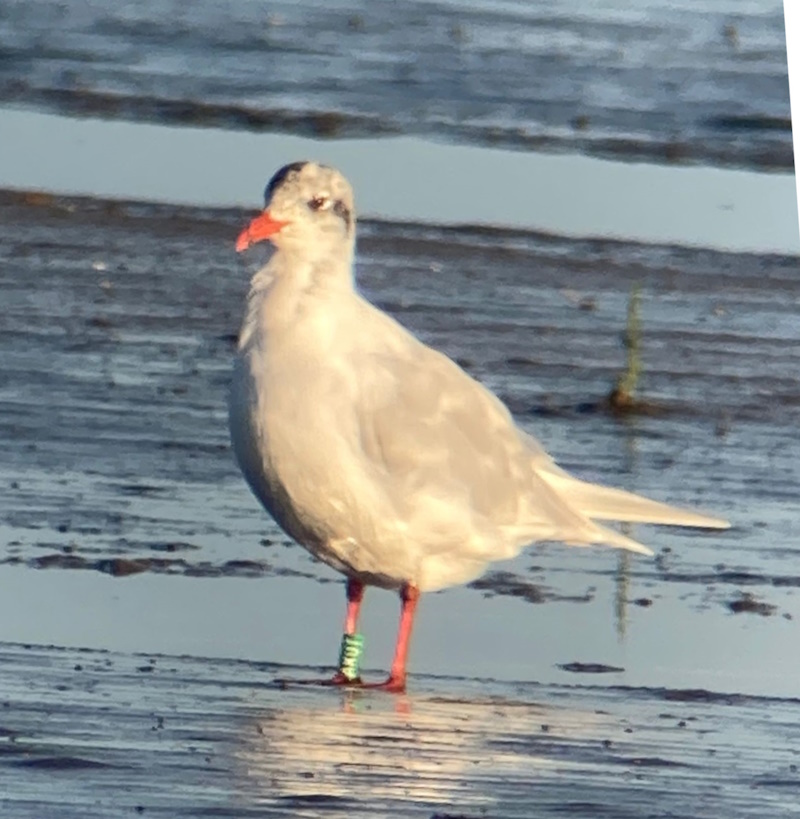
G -AKUT
When Sean sent me
this photo I messaged him back "my guess is that it was ringed a good
number of years ago so it should have an interesting history" - we were
not disappointed! When we got feedback it was a "WOW" moment as it had
been tracked every year since 2012, when it was ringed near Hamburg as
a chick, firstly to various sites around Liverpool Bay then south to
the Iberian peninsula. It seems to be particularly fond of the saltpans
near Faro on the Algarve.
On it's return to Hamburg it was seen to have first
bred in 2015 on a factory roof, and in later years it bred on an island
on the Baltic coast and also on islands on the River Elbe.
Altogether it has been recorded 50 times since it
was ringed. this year, 2024, it was nesting back at its ringing site on
the River Elbe just west of Hamburg, it was then recorded at Heysham
Power Station Outfalls in late June before moving south to Meols on
29/07/2024.
The map illustrates the movements of AKUT, we think
the
movement west after breeding, followed by a movement south to Spain and
Portugal, is likely to be fairly normal for Mediterranean Gulls
generally. Note
there is a gap in sightings between early February (when it is still in
Iberia) and late April, when it returns to Germany. My guess is that it
takes an overland route heading north-east, or may be it just follows
the coast!

Knots
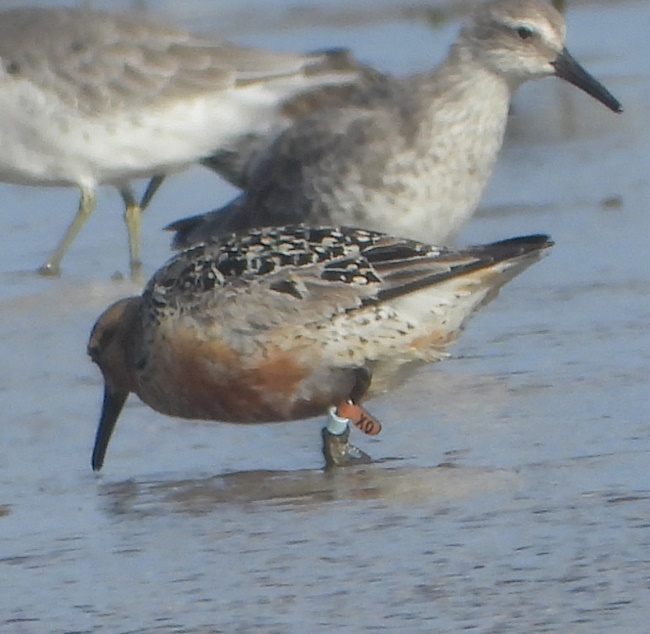
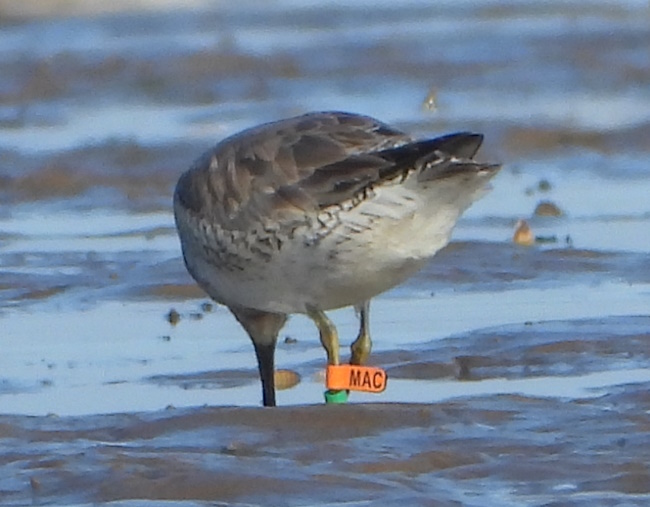
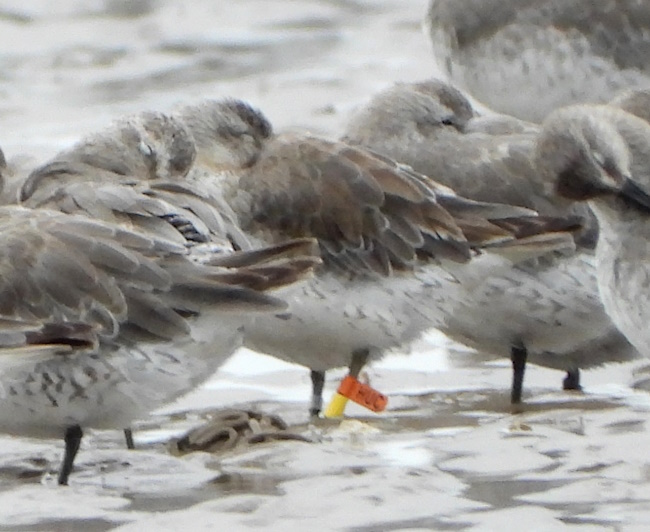
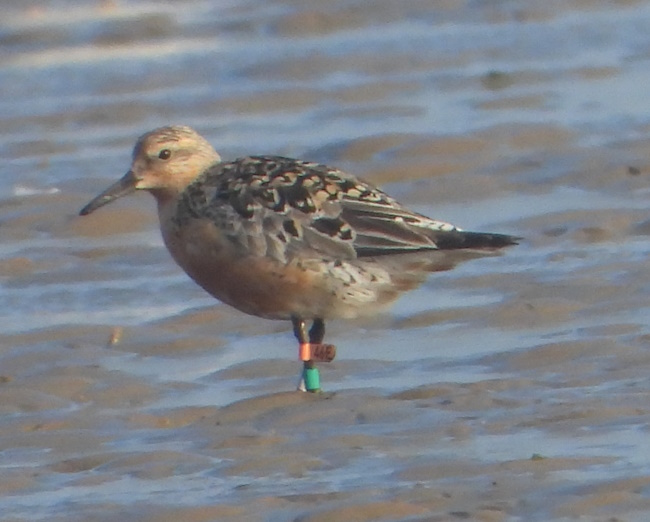
Numbers of colour ringed/flagged knot records on the Dee Estuary/North
Wirral in June and July:
| Year |
Number |
| Prior to 2023 |
1 |
| 2023 |
5 |
| 2024 |
513 |
The table illustrates what a remarkable summer it has been for Knots -
more of which in the next section. With four to five thousand Knots
regularly coming to feed on the shore off Leasowe Gunsite all summer it
gave us ample opportunity to read the flags many of these birds had
been fitted with. The birds were mostly 2CY (i.e. last years chicks)
and it was fascinating to learn of some of their movements with some
flying to the east coast of England and back, and others all the way to
the German end of the Waddensea. Through the second half of July we saw
an increase in 'Red' birds, these were the adults returning from
breeding in Canada, we think most fly all the way back non-stop. It was
awe inspiring looking at these adults knowing the journey they had just
undertaken.
Here is a brief history of the four Knots shown above:
Orange flag(X0)
over Pale blue ring.
This bird was in the first catch which was fitted with orange flags in
September 2017. You can see the wear on the flag but good that the
characters are still easily visible.
It was ringed on the beach near Altcar and all records since have been
between Ainsdale in the north down to Thurstaston in the south.
Orange flag (MAC)
over Green ring.
A brand new flag as it was ringed in May 2024, at Ainsdale.
This bird spent the summer here roosting at Seaforth and feeding at
Leasowe. Up to the end of July it had been recorded five times at
Seaforth
and five times at Leasowe.
Orange flag (HUC)
over Yellow ring.
The yellow ring means it was ringed in Scotland, at
Castle Stuart near Inverness in September 2023 as a juvenile.
It was first recorded at Seaforth in June this year and has since
become a regular at Leasowe being recorded here five times through
July. Very few of the young birds ringed in Scotland have yet made it
to
Liverpool Bay so it was good to see this one.
Orange flag (46E)
over Green ring.
This is an adult ringed at Ainsdale in March 2022. It was recorded in
western Iceland in May that year before being spotted at at Ainsdale in
July, and it was at Formby in August 2023. It was in Dublin Bay in
November 2023 and there have been no more records until it was seen at
Leasowe on July 26th.
Colour Rings were recorded by Richard
Smith, Stephen
Hinde, Colin Schofield,
Tony Ormond, Sean O'Hara, Steve Williams, Alex Jones, Richard
Speechley, Paul Ralston and Peter Haslem.
Richard Smith
July Bird News
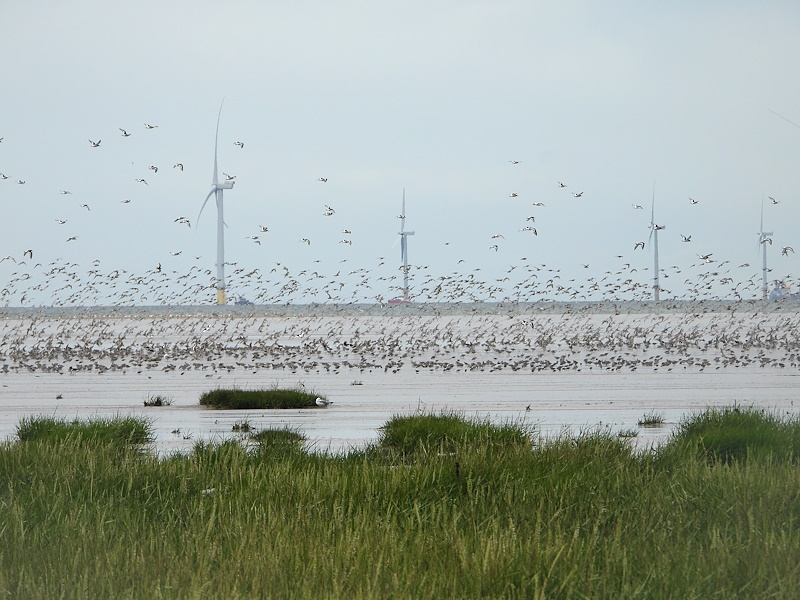
© Richard Smith
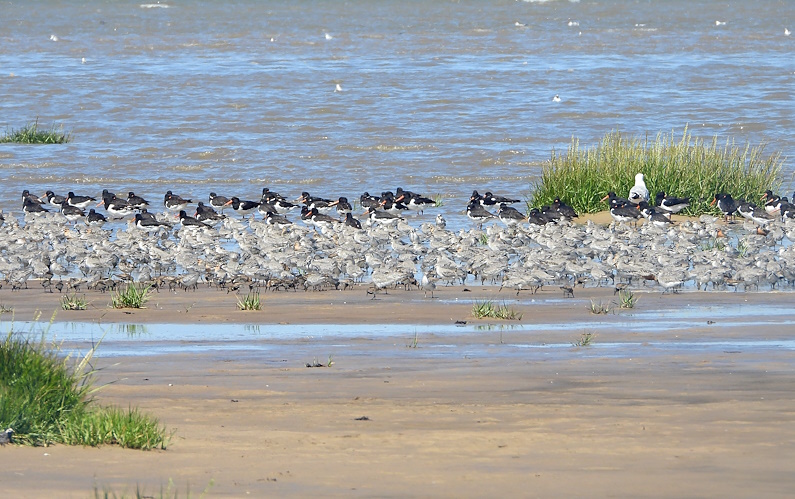
© Richard Smith
The four to five thousand over-summering Knots at
Leasowe, which have been feeding there and roosting at Seaforth, took
to roosting on the eastern end of East Hoyle Bank (off Leasowe
Lighthouse) during the mid-month neap tides. But with the rising tides
over the next few days they were being pushed nearer Hoylake. I watched
in astonishment on the 21st as all five thousand were (mainly) walking
along the tide edge all the way from Leasowe to Hoylake, a distance of
around two miles. The Oystercatchers do this regularly, of course, but
we've never seen Knots undertake this 'March'!
Higher tides over the following two days meant they were pushed close
to Hoylake Lifeboat Station and it was just an amazing sight, as Allan
Conlin's video below, shows. Since being involved with the Liverpool
Bay Knot Project I've had many wonderful days among the Knots, and the
spectacle on the 23rd was right up there with one of the best. For me,
the most surprising thing was the noise with every bird seemingly
'twittering' (for want of a better word), and when 5,000 individual
birds are doing it the volume is surprisingly loud. Just ahead of
the incolming tide the knots themselves appeared to flow along the
shore, flowing around the grass tussocks, one minute surging ahead, the
next pausing and looking for a bite to eat, then surging again. There
is something really special about being close to a large number of wild
birds behaving natuarally, I feel privileged to have witnessed it.
Video taken by
Allan Conlin of the Knots at Hoylake on July 22nd 2024.
Last year I reported "a remarkable 17 Mediterranean Gulls at
Heswall/Thurstaston on 19th July", this year we had 29 there on the
22nd! They were everywhere including overhead, anting, and in various
fields around the area. Several were reported regularly at West Kirby
and Meols with a max at the latter of 12 on the 31st.

Both adults and juveniles were seen, including a juvenile at Connah's
Quay, ringed on the south east coast of England. A 2CY Little Gull and
at least two Yellow-legged Gulls were recorded at Hoylake and Meols
several times during July.

Waders have returned in good numbers including 10,000 Dunlin at Meols
on the 29th and 5,000 Redshank at Heswall on the 30th, the Black-tailed
Godwits at Caldy Wildfowl collection had reached over 4,000 by the
month-end. Rarer waders included a Pectoral Sandpiper at Burton Mere
Wetlands on the 27th. Two Red Kites and at least two Ospreys were seen
through the month.
Sea watching was generally quiet but two Storm
Petrels were spotted in the River Mersey mouth after strong winds on
the 2nd. Up to nine Eiders spent the month off the north end of Hilbre.
Four Spoonbills arrived on the Boathouse Flash,
Parkgate, on the 18th and spent the rest of the month there.
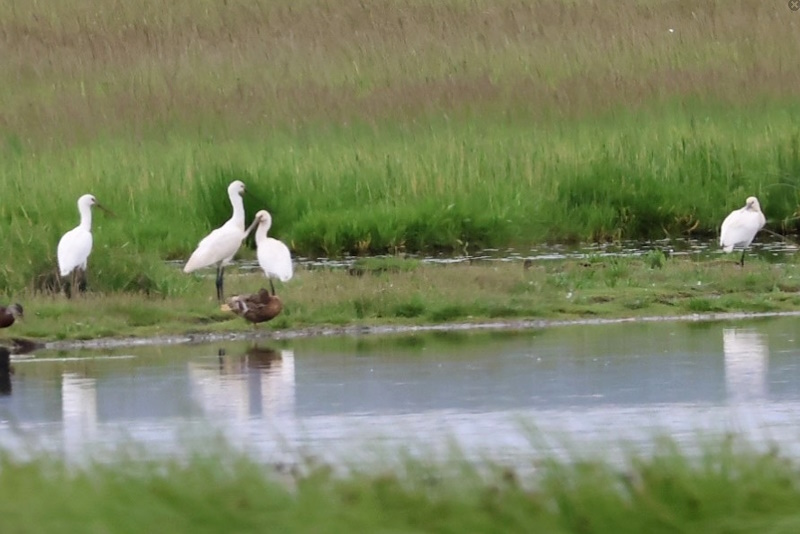
What to expect in August
There will be a lot of terns around with
hundreds of Sandwich Terns at Gronant, Point of Ayr, Hilbre, West Kirby
and Hoylake. The breeding season at our Common and Little Tern colonies
will come to an end early in the month and they will disperse across
the estuary and north Wirral. Black Terns are always a possibilty and
most years a Roseate Tern or two gets spotted.
Waders will be coming back, and passing through, in big numbers. The adults can look a bit scruffy as many will be moulting but then the juveniles will be arriving looking brand new and smart! I like to get down to Hoylake shore on a flooding tide which will be carpeted with Dunlin, Ringed Plovers and Sanderlings. Last year we had at least 2,000 juvenile knots on a couple of the higher tides. Several thousand Redshank, probably the highest number in the country, will be at Heswall and Thurstaston and there will be the amazing sight of at least 5,000 Black-tailed Godwits in one small field at Caldy. Greenshank will also be coming through with the best spots to see these being Parkgate, Connah's Quay NR and Burton Mere Wetlands. Those same sites should also hold a few Spoonbills. Last year we had a good passage of adult Curlew Sandpipers with particularly good views from Meols Prom, and by the month-end we could get the first juveniles arriving.
If we get a strong westerly there should be plenty
of Arctic Skuas to be seen out to sea, along with Gannets and Manx
Shearwaters. A gale at the end of August could blow in an early Leach's
Petrel or two.
August Highest
Tides:
Aug 22nd 13.48hrs (BST) 9.7m
Aug 23rd 14.30hrs (BST) 9.7m
